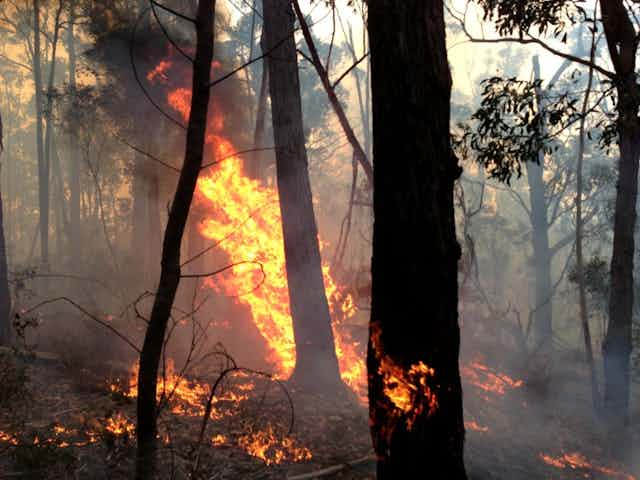Southeastern Australia has had its first taste of summer, with some unseasonably warm weather breaking temperature records for early October. It follows on from a September that was hotter and drier than usual for much of Australia.
One of the reasons for this may be the El Niño Southern Oscillation (ENSO) - the weather phenomenon driven by periodically changing patterns of ocean currents in the Pacific Ocean. Southern Australia’s worst drought years have occurred during the El Niño phase.
Over the past few years a strong La Niña has resulted in California going through its second-worst drought since records began and much of North America has been subjected to wildfires.
However, the system has now reversed and the Australian Bureau of Meteorology is predicting a warmer and drier summer for southern Australia.
Given this, many southern Australians will naturally turn their minds to the question of what the coming fire season will hold – particularly as Victoria’s bushfires have already claimed their first house.
Where there’s heat, there may be fire
The Bushfire and Natural Hazards Cooperative Research Centre recently released its seasonal bushfire outlook for the summer of 2015-16.
This report was compiled in a workshop attended by a range of climatologists and fire and land managers, considering a range of climate factors such as the amount of rainfall in previous months and the long-term rainfall deficit.
They concluded that the pattern of long-term, below-average rainfall and above-average temperatures mean that soil moisture and fuels are prone to rapid drying with the approach of summer.
While the conditions indicate an above-average fire season for many of the southern states, the temperature and rainfall patterns of the coming months will be crucial. As a result, fires may be more likely and more severe.

Dry conditions in forests mean that areas that are typically too wet to burn can become flammable. This means that stopping fires can become challenging as natural barriers (such as wet gullies) are ineffective. As a result, forest fires that occur in dry years have the potential to become very large – two recent fires in southeastern Australia (in 2003 and 2007) reached over 10,000 square kilometres in size.
Not a matter of if, but where and when
Forewarning of a bad season can allow land managers and fire agencies to prepare and make the fires that do happen more easy to manage. This includes investing in firefighting services, prescribed burning, educating the community and developing warning systems.
Fires have been occurring in Australia for many thousands of years. The nature of our weather patterns (hot, dry and windy during the summer) and our forests (containing species that have features that promote the spread of fire, such as stringy-barked eucalypts) means that fires will always be a feature of the landscape.

But when fires occur, they can affect things we value. While there has been a great deal of attention to protecting life and property, fires can also impact on cultural values, health, water quality, agricultural productivity and biodiversity values.
This is particularly relevant in Victoria, which has seen greater bushfire activity in the last 15 years. Of the 8.6 million hectares of land burned in wildfires in Victoria since the 1950s, half of this amount (4.3 million ha) burned between 2003 and 2014. Climate change projections indicate that the frequency and intensity of fires are likely to increase in many parts of Australia.

When, as in this case, recent bushfires have affected a significant proportion of the landscape, the effects of future fires may become less certain and potentially exacerbated. For example, frequent fires may impact certain vegetation types more than others, potentially reducing their capability to regenerate.
An example of this is the high-altitude species alpine ash (Eucalyptus delegatensis). Ash forests are particularly vulnerable to frequent wildfires. If they are burned twice in a short period (less than 20 years), they may become locally extinct. This can have serious implications for the capacity of these ecosystems to store carbon, create habitat and provide the multitude of other values they offer.

Time to get ready
We don’t known when and where damaging fires will occur. For example, the Black Saturday fires of 2009 (Australia’s worst bushfire disaster) occurred under neutral El Niño conditions. Fires can occur at any time when conditions are hot and windy enough, there is sufficient dry vegetation (fuel) and an ignition source.
While the landscape managers and fire agencies can reduce risk, they cannot be expected to eliminate it all. It is up to us to ensure that we remain safe during the fire season, recognising the contribution of our own decisions to our safety. By preventing fires, we can also protect much more than ourselves.
Here are four things you can do to help yourself and others:
Familiarise yourself with the advice on your local fire agency website
When you are in fire-prone areas, ensure preparations are made to prepare for the fire season (such as preparing defensible space and identifying what needs protection)
-
Have a plan (with contingencies) about what to do on bad fire days and during a fire (that is, whether to leave early and live or to stay and defend. Consider also how to look after pets and vulnerable people.)
- Keep up to date with information (particularly when travelling in fire-prone areas).
While such actions might feel like a burden, it is a necessary cost of living in a fire-prone landscape like Australia.

